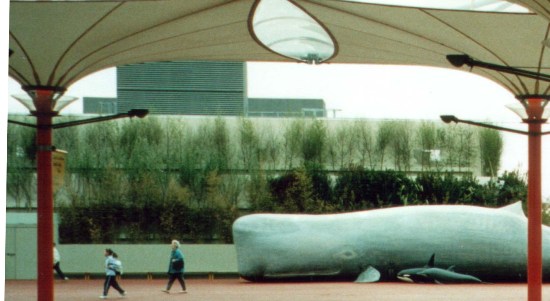Green walls
[edit] Introduction
The government’s 25 Year Environment Plan drives forward the agenda of a ‘cleaner and greener’ Britain. The plan lays out the government’s intention to enforce mandatory requirements on developers to integrate green infrastructure in the built environment. It seeks to integrate more stringent green considerations into building planning, and successfully captures the shift in sustainability goals by embedding an ‘environmental net gain’ principle.
The challenge faced in increasingly dense cities such as London however, is the scarcity of open areas for the development of green space. The solution is to be innovative with the space we do have. Integrating green infrastructure in dense, inner-city space is possible by seeking opportunities on buildings’ facades, transforming the dull, urban grey into green walls.

|
[edit] Green walls
More than just attractive architectural statements of environmental consciousness, green walls have a role to play in improving our cities as the rate and intensity of urbanisation accelerates.
Green walls provide large surface areas for pollutant deposition and can result in local reduction in concentrations of particulate matter between 10-20%. Within street canyons, this can increase to a reduction of particulate matter by 60% and nitrogen dioxide by 40%.
In addition to air quality, green walls are a key component of a city’s functional network of green spaces. Not only do they provide new habitats, but they also facilitate movement between habitats by contributing to networks of green corridors across vast urban space.
The benefits of green walls are not limited to the environmental but also span across the social reaches of sustainability. Green walls present an opportunity to use limited space to improve the quality of life for people in urban areas. The positive links made between the natural environment and an individual’s sense of wellbeing, stress reduction and mental regeneration are amongst the well-established restorative benefits of contact with nature. Studies also show that green facades can absorb sound energy that would normally be reflected by concrete, glass and steel and can reduce sound levels from traffic by 15dB. This minimises the excessive noise that threatens the wellbeing of urban residents.
Green walls provide a healthy and functional way for cities to become more attractive, resilient and increase the quality of living for residents, whilst competing with issues of diminishing space in inner-urban environments.
At the East Wick and Sweetwater project, the project team sought to improve residents’ quality of life and the local environmental conditions within the Queen Elizabeth Olympic Park by designing in green walls on the facades of the new developments.
The green roofs on the St James’ Market project form part of The Crown Estates “Wild West End” strategy to connect St James’s Park in the south to Regents Park in the north via a building-integrated green corridor.
[edit] Related articles on Designing Buildings Wiki
Featured articles and news
RTPI leader to become new CIOB Chief Executive Officer
Dr Victoria Hills MRTPI, FICE to take over after Caroline Gumble’s departure.
Social and affordable housing, a long term plan for delivery
The “Delivering a Decade of Renewal for Social and Affordable Housing” strategy sets out future path.
A change to adoptive architecture
Effects of global weather warming on architectural detailing, material choice and human interaction.
The proposed publicly owned and backed subsidiary of Homes England, to facilitate new homes.
How big is the problem and what can we do to mitigate the effects?
Overheating guidance and tools for building designers
A number of cool guides to help with the heat.
The UK's Modern Industrial Strategy: A 10 year plan
Previous consultation criticism, current key elements and general support with some persisting reservations.
Building Safety Regulator reforms
New roles, new staff and a new fast track service pave the way for a single construction regulator.
Architectural Technologist CPDs and Communications
CIAT CPD… and how you can do it!
Cooling centres and cool spaces
Managing extreme heat in cities by directing the public to places for heat stress relief and water sources.
Winter gardens: A brief history and warm variations
Extending the season with glass in different forms and terms.
Restoring Great Yarmouth's Winter Gardens
Transforming one of the least sustainable constructions imaginable.
Construction Skills Mission Board launch sector drive
Newly formed government and industry collaboration set strategy for recruiting an additional 100,000 construction workers a year.
New Architects Code comes into effect in September 2025
ARB Architects Code of Conduct and Practice available with ongoing consultation regarding guidance.
Welsh Skills Body (Medr) launches ambitious plan
The new skills body brings together funding and regulation of tertiary education and research for the devolved nation.
Paul Gandy FCIOB announced as next CIOB President
Former Tilbury Douglas CEO takes helm.
UK Infrastructure: A 10 Year Strategy. In brief with reactions
With the National Infrastructure and Service Transformation Authority (NISTA).























